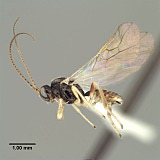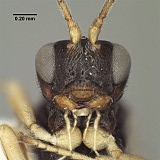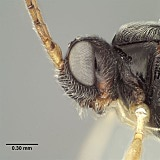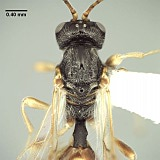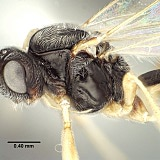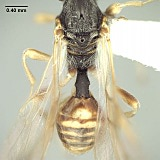Stigmatopoea norrbomi Wharton, 2012
This species is named after the collector, Allen Norrbom, who has provided many valuable host records for tephritid parasitoids.
Mesosoma 1.35-1.45 x longer than high; 1.8-1.9 x longer than wide; 1.3-1.4 x higher than wide. Pronotum dorsally as in E. maya but with slightly enlarged pit in middle of crenulate groove consistently present; crenulae extending in shallow groove onto pronotum laterally, covering dorsal 0.2-0.6; groove margined anteriorly as in E. maya. Anterior declivity of mesoscutum completely vertical, densely covered with white, decumbent setae except for bare median band extending posteriorly to midpit; anterior-lateral corners of mesoscutum at upper edge of declivity elevated, rounded, densely setose, the setal pattern extending in broad bands all along notauli and laterally from anterior declivity to tegula; notauli complete, extending from anterior margin to scuto-scutellar sulcus, weakly converging posteriorly alongside but not into tear-drop shaped midpit; crenulate throughout, with sculpture extending laterally around margin to tegula, sculpture largely obscured by dense setae; lateral lobes of mesoscutum bare posterior-medially. Scuto-scutellar sulcus 4-5 x wider than midlength, lateral margins difficult to discern due to setal density; with low midridge and indistinct crenulae on either side; otherwise as in E. maya. Scutellum as in E. maya except with long marginal setae extending medially to cover most of posterior 0.5. Propodeum extensively rugulose, obscuring nearly all traces of carinae; pleural carina weak, often indistinct, very short median carina often present basally; transverse carina rarely weakly indicated across middle; propodeum uniformly setose anteriorly, with a few scattered setae posteriorly. Mesopleuron as in E. maya except subalar region densely setose and groove below subalar ridge varying from nearly smooth to weakly rugulose. Precoxal sulcus distinctly impressed, unsculptured. Metapleuron a little more extensively setose but otherwise as in E. maya.
Wings. Fore wing stigma parallel-sided, discrete posteriorly, 6.3-6.6 x longer than wide; r1 arising from basal 0.35; 1RS (excluding parastigma) 0.25-0.35 x length of 1M; RS+M weakly sinuate; 3RSa 1.05-1.30 x longer than 2RS; 2RS 2.6-3.1 x longer than r; 2RS and 3RSb straight; 3M variable, but often pigmented and sclerotized for most of its length; 2CUa 0.8-0.9 x length of 2cu-a, 2CUb arising slightly above middle of first subdiscal cell; position of m-cu, 1cu-a, and 1-1A, shape of second submarginal cell, and angle between r1 and 2RS as in E. maya. Hind wing as in E. maya.
Metasoma distinctly petiolate; head 3.75-4.10 x wider than apex of T1. T1 2.2-2.5 x longer than apical width; nearly parallel-sided, with apex 1.20-1.35 x wider than base; surface granular coriaceous throughout; completely without subapical depressions dorsally; dorsope, laterope, dorsal carinae, dorsal surface of T1 in profile, as in E. maya; lateral carina at least partially present but difficult to distinguish from surrounding sculpture. S1 extending about 0.25-0.30 x length of T1; T2 and following without sharp lateral margins; spiracle of second metasomal terga laterally displaced, only partially visible in dorsal view. Ovipositor shorter than mesosoma, base not visible in type series, but total length approximately 0.6-0.7 x length of mesosoma; ovipositor sheath 0.30-0.35 x length of mesosoma, with setal pattern as in E. maya.
Color: Mesosoma, T1, S1, ovipositor sheath, and most of head dark brown to black; antenna yellow basally, apical 0.3 brown; mandibles yellow; palps white; lower gena adjacent malar sulcus brown to brownish red; ventral 0.3-0.4 of clypeus yellow to brownish red. Tegula reddish brown with yellow margin. Legs yellow to pale yellow except most of hind coxa, apical 0.6-0.7 of hind femur, and fifth tarsomere of all legs brown; hind tibia vaerying from weakly infumate to light brown, basal 0.2 nearly always pale yellow. T2 mostly brownish red with median yellow blotch posteriorly; T3 yellow with anterior and lateral margins brownish red; T4-T&6 yellow with anterior and lateral margins dark brown; visible parts of remaining terga yellow.
Male. As in female except antenna with 37 flagellomeres; eye in dorsal view 1.55-1.75 x longer than temple; width of ocellar field 1.05-1.10 x distance from ocellar field to eye. Color same except visible parts of apical terga dark brown.
Body length 2.8-3.5 mm; wing length 3.2-3.6 mm.

